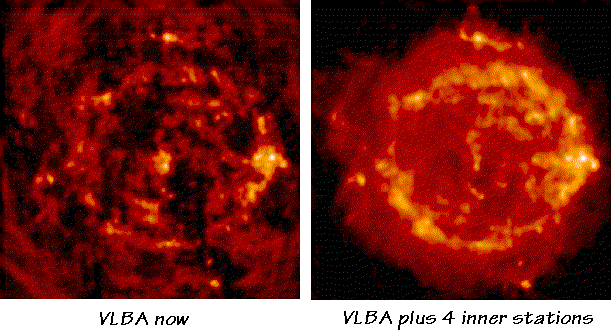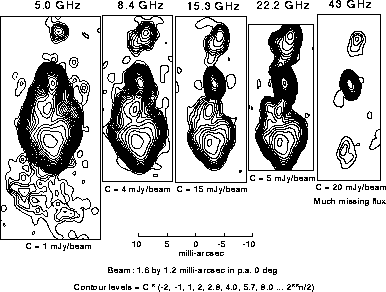IMPACT ON SCIENCE WITH THE VLBA




Next:
SUMMATION Up:
OVERVIEW Previous:
Objects at High
The NRAO now operates 37 ``synthesis array elements", broken
into a 27-element sub-array (the VLA) and a 10-element sub-array (the
VLBA), with only one provision for cross-linking them (using one
antenna or the whole VLA in its phased-array mode for VLBI). Much
could be gained by allowing individual elements of the VLA and VLBA to
join in observations with the other array, especially if we build the
new antennas described earlier.
First, the information gathered
by an  -element
synthesis array varies as the number of baselines, i.e., as
-element
synthesis array varies as the number of baselines, i.e., as
 for large
for large  . Linking even four
VLA antennas to the VLBA would double the information content
of VLBA observations by doubling the number of correlations. This
doubled information content would translate into improved image
quality via (i) a wider field of view, (ii) improved sensitivity to
extended structures, and (iii) increased dynamic range (image
fidelity) for the VLBA. The more ambitious world-array VLBI
experiments have also shown that the apparent simplicity of typical
VLBI images reflects a lack of information gathered about the sources
more than any intrinsic simplicity of Nature on these scales. We can
expect many extragalactic sources to have complex structures on scales
from 1 to 100 milli-arcseconds. Physical interpretation of these
structures will require images with high dynamic range and wide fields
of view over a large range in frequency.
. Linking even four
VLA antennas to the VLBA would double the information content
of VLBA observations by doubling the number of correlations. This
doubled information content would translate into improved image
quality via (i) a wider field of view, (ii) improved sensitivity to
extended structures, and (iii) increased dynamic range (image
fidelity) for the VLBA. The more ambitious world-array VLBI
experiments have also shown that the apparent simplicity of typical
VLBI images reflects a lack of information gathered about the sources
more than any intrinsic simplicity of Nature on these scales. We can
expect many extragalactic sources to have complex structures on scales
from 1 to 100 milli-arcseconds. Physical interpretation of these
structures will require images with high dynamic range and wide fields
of view over a large range in frequency.

Figure 1.2:
(left) An image obtained by using the full u-v
coverage of the present VLBA at  21cm to sample a model derived from
the radio structure of the supernova remnant Cassiopeia A, rescaled to
a distance of 1 Mpc. Only the most compact emission is represented at
this resolution (FWHM
21cm to sample a model derived from
the radio structure of the supernova remnant Cassiopeia A, rescaled to
a distance of 1 Mpc. Only the most compact emission is represented at
this resolution (FWHM  8 milli-arcsec).
8 milli-arcsec).
(right) An image obtained by sampling the same model with the
full u-v coverage obtained by adding the Dusty, Bernardo,
Holbrook and Vaughn antennas to the VLBA. The FWHM of the synthesized
beam increases by only about 4% but the larger-scale structure of the
remnant is now correctly represented at this resolution. Neither
simulation is noise-limited.
Second, the VLA and VLBA, taken separately, leave the 40-400 km
range of baselines relatively unsampled. This ``coverage gap"
obstructs work on many astrophysical problems. For example, the VLA
now images well down to about  FWHM at
FWHM at  2cm and proportionally lower
resolution at longer wavelengths. The VLBA images up to a few
milli-arcsec at
2cm and proportionally lower
resolution at longer wavelengths. The VLBA images up to a few
milli-arcsec at  2cm. They fail to meet by about a
factor of ten in resolution at any frequency. The missing regime is
now of great interest to AGN jet dynamics, observations of galactic
X-ray transients, of circumstellar masers, proto-planetary disks, and
of supernova remnants in external galaxies.
2cm. They fail to meet by about a
factor of ten in resolution at any frequency. The missing regime is
now of great interest to AGN jet dynamics, observations of galactic
X-ray transients, of circumstellar masers, proto-planetary disks, and
of supernova remnants in external galaxies.
Figure 1.2 illustrates how the
new antennas proposed for the A+ configuration could also improve
image quality when used to provide short-baseline u-v coverage
in observations with the VLBA. As in Section 1.2.5, we consider
observing a ``twin'' of the Cas A supernova remnant at a distance of
about 1 Mpc, so the angular extent of the remnant is about  . The left panel shows
the image that could be obtained at
. The left panel shows
the image that could be obtained at  21cm with the present VLBA. The
right panel shows the dramatic improvement obtainable by adding the
data from the proposed new antennas.
21cm with the present VLBA. The
right panel shows the dramatic improvement obtainable by adding the
data from the proposed new antennas.

Figure 1.3: Preliminary VLBA images of the nucleus of the active galaxy
3C84 at five frequencies. Note the differing sensitivities. The
extent to which the detailed differences between these images are real
frequency-dependent properties of the source (rather than differences
in the u-v coverage of the VLBA at these frequencies) would be
unclear even with matched sensitivities. The 43-GHz image clearly
under-samples the broader (>5 milli-arcsec) structure in the
lower-frequency images, however: it accounts for only about 3/4 of the
known total flux density. These uncertainties could be eliminated by
cross-linking the expanded VLA and the VLBA to provide a scaled-array
capability, especially at the highest frequencies.
Third, it is important to realize that the VLBA has very little
``scaled-array" capability because of its small number of
antennas (image quality deteriorates rapidly if any antennas are
removed at one frequency to ``match" the coverage at another) and
because it is not reconfigurable. We can have multi-frequency coverage
at a fixed angular resolution only by adding data from baselines
shorter than 400 km at the higher frequencies (e.g., Figure 1.3). Cross-linking an expanded VLA with the VLBA will
extend the scaled-array capability of both instruments to cover
a huge domain of angular resolution, providing well-filled u-v
coverage, scaled with wavelength over a wide frequency range. For
example, when studying relativistic jets in AGNs or galactic X-ray
transients, we must be able to image total and polarized emissions at
the same resolution over a wide range of frequencies to determine
spectral energy distributions, Faraday rotations and magnetic field
directions, as well as the collimation and proper motion information
that are available from single frequencies.
Although a foreign ``100-km" array (e.g., MERLIN) can provide some of the
``missing coverage" at  >6cm for northern sources, the
high-frequency coverage that is critical to much of the astronomical
program, and the
>6cm for northern sources, the
high-frequency coverage that is critical to much of the astronomical
program, and the  ``baseline synergy" with the VLA
or VLBA can be obtained only with antennas in the Southwestern
U.S.
``baseline synergy" with the VLA
or VLBA can be obtained only with antennas in the Southwestern
U.S.
Ultimately, to study how the properties of astronomical sources change
with frequency without changing resolution, we should be able to
select antenna combinations to create the appropriate set of matched
spatial filters for any given multi-frequency experiment. We could do
this at high angular resolution if we were able to choose
``sub-arrays" that include VLA and VLBA baselines almost
interchangeably. The NRAO prepared for this by siting the VLBA
antennas around the VLA as their centroid, and by co-locating the main
VLA and VLBA operations centers. The VLA Expansion is needed to
exploit the unique opportunity that this creates. It gives us a way
to transform the scientific capabilities of two major
instruments significantly at once.
To take full advantage of this, we should also plan to outfit the new
antennas and a few existing VLA antennas with VLBA back-ends. The new
antennas would be operated as part of the VLBA for much of the time
that the VLA is in its more compact configurations and would need VLBA
data acquisition systems. It is also desirable to have enough
hardware at the VLA site itself to record signals from 4 VLA antennas
at once. An upgrade of recording and formatter systems to reach 1 or 2
Gbps in a mode compatible with Mark IV is also desirable. Astrometric
VLBI observations would benefit from a 2.4 GHz/8.4 GHz (S/X) dual
frequency system.
This Science Workshop was directed only toward examining the
astronomical motives for operating the new antennas as the VLA`s A+
configuration. A further working group is now being set up to explore
the impact of the VLA Extension on science with the VLBA.




Next: SUMMATION
Up: OVERVIEW
Previous: Objects at High
newvla@nrao.edu
 -element
synthesis array varies as the number of baselines, i.e., as
-element
synthesis array varies as the number of baselines, i.e., as
 for large
for large  . Linking even four
VLA antennas to the VLBA would double the information content
of VLBA observations by doubling the number of correlations. This
doubled information content would translate into improved image
quality via (i) a wider field of view, (ii) improved sensitivity to
extended structures, and (iii) increased dynamic range (image
fidelity) for the VLBA. The more ambitious world-array VLBI
experiments have also shown that the apparent simplicity of typical
VLBI images reflects a lack of information gathered about the sources
more than any intrinsic simplicity of Nature on these scales. We can
expect many extragalactic sources to have complex structures on scales
from 1 to 100 milli-arcseconds. Physical interpretation of these
structures will require images with high dynamic range and wide fields
of view over a large range in frequency.
. Linking even four
VLA antennas to the VLBA would double the information content
of VLBA observations by doubling the number of correlations. This
doubled information content would translate into improved image
quality via (i) a wider field of view, (ii) improved sensitivity to
extended structures, and (iii) increased dynamic range (image
fidelity) for the VLBA. The more ambitious world-array VLBI
experiments have also shown that the apparent simplicity of typical
VLBI images reflects a lack of information gathered about the sources
more than any intrinsic simplicity of Nature on these scales. We can
expect many extragalactic sources to have complex structures on scales
from 1 to 100 milli-arcseconds. Physical interpretation of these
structures will require images with high dynamic range and wide fields
of view over a large range in frequency. 
 21cm to sample a model derived from
the radio structure of the supernova remnant Cassiopeia A, rescaled to
a distance of 1 Mpc. Only the most compact emission is represented at
this resolution (FWHM
21cm to sample a model derived from
the radio structure of the supernova remnant Cassiopeia A, rescaled to
a distance of 1 Mpc. Only the most compact emission is represented at
this resolution (FWHM  8 milli-arcsec).
8 milli-arcsec). FWHM at
FWHM at  . The left panel shows
the image that could be obtained at
. The left panel shows
the image that could be obtained at 